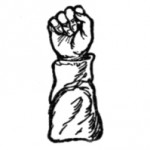Search the internet for “religion AND science,” and you’ll find plenty on creationism, Richard Dawkins, and the so-called “God spot” (where the brain seems to process religious experiences). You will also find heaps of commentary, most of which assumes either that Religion and science can never peacefully coexist, or that Religion and science get along just fine.
Here at The Cubit, Religion Dispatches’ new religion and science portal, we view much of the religion-versus-science debate as hopelessly myopic. Yes, humans are a product of evolution, global warming is real, and vaccines do not cause autism; but religion and science nevertheless remain diverse, messy, and ever-evolving concepts. When we typecast them as epistemological sumo wrestlers locked in an eternal struggle, or portray them as happy lovers, we overlook their far subtler interactions and dull the impact when meaningful sites of coexistence or conflict do appear.
The Cubit will be skeptical of dogmatic rhetoric, whether it’s found in religious sermons, scientific triumphalism, or feel-good compromises that ignore the critical distinctions between religion and science. We will examine the pieties of secular liberals every bit as critically as those of religious conservatives, and we won’t shy away from the politics of power that underlie so many of our science-and-society debates.
Drawing on a diverse group of experts and sources, The Cubit will cover old standbys like creationism and the cosmos, but we’ll also tackle gluten purity laws and GMO debates; the ethical hazards of Silicon Valley; the neuroscience of human identity; interpretations of sexuality; techno- (and traditional) apocalypticism; animal rights; and more. In short, whenever science, religion, technology, and ethics are entangled, you’ll find surprising and provocative perspectives at The Cubit.
The cubit is an ancient unit of measurement, based on the length between the elbow and the tip of the middle finger. Ancient China, ancient Egypt, the Roman Empire, and other cultures independently made the forearm a standard of measure. And why not? It’s convenient and ubiquitous. When you lift a hammer, it’s already sitting at the end of a cubit.
We chose this humble unit for two reasons.
First, the cubit is an intersection; it’s where the human body meets the material world. In the Bible, it’s where divine law (“build this ark, Noah!”) meets physical form (“and do so using the measurement of your arm”).
Second, the cubit is a human measurement. Many cultures did try to standardize the length of a cubit, but when you return to the origins of those standardized measurements, there had to be a specific person’s actual arm—physical, unabstractable, imprecise (and perhaps a little hairy).
So the cubit is both a symbol of the relationship between science and religion and a reminder that scientific findings come, ultimately, from the work of actual people. The holy grail of science may be to uncover the laws of objective reality, yet human-driven science—like religion—remains subject to human concerns and flaws.
Who we are
Andrew Aghapour is a Ph.D. candidate at the University of North Carolina, Chapel Hill, where he studies religion and the brain.
Michael Schulson is a freelance writer in Durham, N.C. He has covered religion, science, and culture for The Daily Beast, Aeon, Salon, and Religion & Politics, among others.
Both Andrew and Michael have written about religion-and-science issues for RD, covering robot theology, multiverse theory, Katie Couric’s reincarnation episode, and the effects of analytic thinking on religious beliefs.





